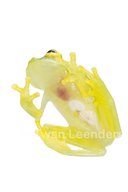|
Hyalinobatrachium talamancae (Taylor, 1952)
Green-striped Glass Frog | family: Centrolenidae subfamily: Hyalinobatrachinae genus: Hyalinobatrachium |
 © 2017 Twan Leenders (1 of 14) |
|
|
|
Description The head is broad with a snout that is rounded in profile and weakly pointed in dorsal view, protuberant nostrils, and a tympanum that is indistinct (Savage 2002). The pupil is elliptical (Kubicki 2006). Finger I is longer than finger II and fingers have truncated discs (Savage 2002). Webbing is vestigial between finger I and II but varies between specimens as to the other fingers, with extensive webbing between Fingers III-V in some specimens (Kubicki 2006). Toes are rounded, with extensive webbing (Savage 2002). Males do not have nuptial pads (Savage 2002). The inner metatarsal tubercle is small, round, and flattened, while the outer metatarsal tubercle and tarsal fold are lacking (Savage 2002). Bones are yellowish white (Kubicki 2006). It has a colorless pericardial sac, leaving the red heart visible, but the liver and other digestive organs have a white visceral covering (Kubicki 2006). The skin surface is shagreened dorsally and is green with moderate-size yellow spots (Savage 2002). The venter is transparent, while the ventral surfaces of limbs are flesh-colored (Savage 2002). The iris is gold with small black dots (Kubicki 2006). Hyalinobatrachium talamancae is similar to H. fleischmanii but can be distinguished by the rounded snout in profile (vs. truncated in H. fleischmanii), protuberant nares (vs. no narial swellings in H. fleishmanii), and an indistinct tympanum (vs. a hidden tympanum in H. fleishmanii) (Savage 2002). It is also similar to H. vireovittatum but differs from that species by lacking paired yellow paravertebral stripes (vs. yellow paravertebral stripes present on either side of the green mid-dorsal line in H. vireovittatum) (Kubicki 2006). Distribution and Habitat Country distribution from AmphibiaWeb's database: Costa Rica
Life History, Abundance, Activity, and Special Behaviors Trends and Threats Comments A Spanish-language species account can be found at the website of Instituto Nacional de Biodiversidad (INBio).
References
Kubicki, B. (2006). ''Rediscovery of the Green-striped Glass Frog Hyalinobatrachium talamancae (Anura: Centrolenidae) in Costa Rica .'' Brenesia , 66, 25-30. Kubicki, B., Bolaños, F., Chaves, G., Solís, F., and Ibáñez, R. (2004). Hyalinobatrachium talamancae. In: IUCN 2009. IUCN Red List of Threatened Species. Version 2009.1. www.iucnredlist.org. Downloaded on 28 July 2009. Savage, J. M. (2002). The Amphibians and Reptiles of Costa Rica:a herpetofauna between two continents, between two seas. University of Chicago Press, Chicago, Illinois, USA and London. Taylor, E.H. (1952). "A review of the frogs and toads of Costa Rica." University of Kansas Science Bulletin, 35(5), 577-942. Originally submitted by: Lettie Gallup (first posted 2009-06-30) Edited by: Kellie Whittaker (2009-11-02) Species Account Citation: AmphibiaWeb 2009 Hyalinobatrachium talamancae: Green-striped Glass Frog <https://amphibiaweb.org/species/1827> University of California, Berkeley, CA, USA. Accessed May 12, 2025.
Feedback or comments about this page.
Citation: AmphibiaWeb. 2025. <https://amphibiaweb.org> University of California, Berkeley, CA, USA. Accessed 12 May 2025. AmphibiaWeb's policy on data use. |



 Map of Life
Map of Life